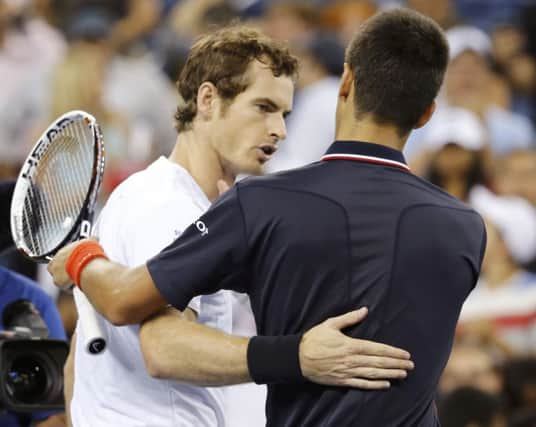Andy Murray shows he can challenge again


Everyone around him knew his three-and-a-half hours on court with Novak Djokovic was proof positive that Murray was within touching distance of being at his peak. For two-and-a-half sets of his 7-6, 6-7, 6-2, 6-4 defeat to the world No 1, he had stood toe-to-toe with his oldest rival. He had hit his forehand like never before, he had found spaces the size of postage stamps upon which to land his backhand, he had stepped into his returns – he was playing like a grand slam contender.
But it could not last. The first two sets took more than two hours and when he missed two chances to break back at the start of the third set, the bubble had burst. His legs were turning to jelly and, as a result, his hips and back began to stiffen up.
Advertisement
Hide AdAdvertisement
Hide AdHad he played these sorts of matches against this sort of opponent on a regular basis throughout the year, there would have been more running in his aching body, more match toughness in his legs. But the back surgery he had a year ago had hampered his progress for the first half of the year and he had not played a match like this since the Wimbledon final. Meanwhile, Djokovic, as the Wimbledon champion and French Open finalist, was mentally and physically as tough as titanium.
“I haven’t played enough matches at that level this year,” Murray said sadly. “It’s obviously different playing at that level, playing against the No 1 in the world and the way that we play against each other, it’s just an extremely physical match. When me and Novak play against each other, you obviously see very tight, long rallies. Both of us do a lot of running.
“It doesn’t matter how much training you do, when you get on the match court it’s different. I can’t practice with the best player in the world, so it’s tough to practice at that intensity.”
Even so, the way he played and the way he fought – he came back from a break down in the first two sets – was the most encouraging sign yet that Murray is ready to challenge for the major titles again.
This year may be almost over but the new season awaits – and in 2015, Murray will be ready to chase Djokovic and his like from continent to continent in pursuit of the major prizes. Murray could not see it as he sat in a cold interview room at 2am but Boris Becker, Djokovic’s coach, was well aware that the Scot was back in business.
“The first two-and-a-half sets Andy hit the ball as cleanly as I have seen him do it in a long time,” Becker said. “He hit the forehand hard but maybe it took its toll. The serve, forehand and backhand package was Andy at his very best. It seemed like his back stiffened up towards the end, but then it is hard to play against Novak – he is the fittest guy on tour.
“I would expect Andy to have a good finish to the season on that evidence. There’s a good base for him to work from over the next six months.”
Even in the fourth set when his back was hurting and he was physically spent, Murray would not give in. It would have been easy to roll over and take a swift hiding and then get off court and recover, but that is not Murray’s way.
Advertisement
Hide AdAdvertisement
Hide AdShuffling around the back of the court between points, dragging his heels like an eight-year-old on his way to school, he looked done. And then, at the hint of a second serve or a short ball, he was on it like a flash to try and clatter the winner. Only when he served to stay in the match did it all catch up with him – and Djokovic knew it.
“He didn’t give me a lot of rhythm in the fourth,” a relieved Djokovic said. “I thought I won my service games quite comfortably, but I wasn’t managing to make the difference in his service games because he was just going for his shots and they were going in. And in the most important moment in 5-4 in the fourth he made a couple of errors. I stayed in the point, and that’s what brought me a win.”
It is the grand slam events that whet the appetites of the men at the top of the game. The smaller tournaments are all well and good but they are not what the likes of Djokovic, Murray and Federer work for.
Between now and Christmas, Murray has two Masters 1000 events to play and, perhaps, the ATP Finals in London if he qualifies. But he is not prepared to fling himself around the circuit chasing points to earn his ticket to the end-of-season jamboree; Murray wants to win more grand slams and he will pace himself this autumn in order to prepare properly for the Australian Open in January. But January seemed like a lifetime away on Wednesday night.
“I set my goals up to now, basically, and did everything after Wimbledon to prepare for now, for the US Open,” he said.
“Right now I’m obviously disappointed. But I think there was some good tennis. I obviously haven’t analysed the match or had time to think about it yet but I think there was some good tennis there. Hopefully I can build on that.
“I think I can do better. But it’s a shame. Obviously, the slams are over for this year, so I have to wait a few months before the next one.”
When the disappointment of Wednesday’s defeat wears off and January comes around, Murray will be ready. There are many positives to extract from his trip to New York and, in time, he will find them.